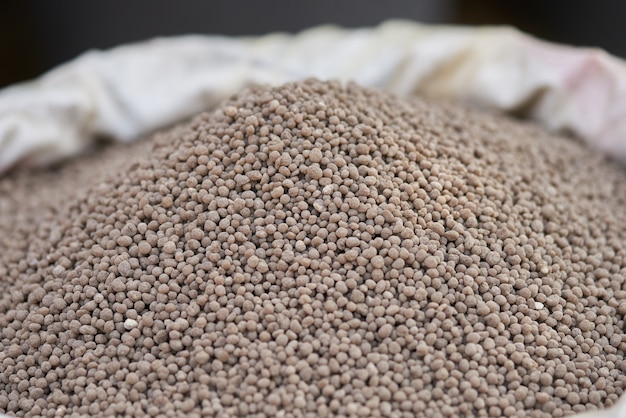The newly Diammonium Phosphate (DAP) market report provided a complete view of the present and future market. Deep analysis of enterprise competition pattern, enterprise product advantages and disadvantages, regional industrial layout characteristics. The base year considered for the study is 2018 and the market size is projected from 2019 to 2026.
Product Information
DAP is a salt which is soluble in water. DAP is manufactured by a chemical reaction between phosphoric acid and ammonia. It majorly finds utility in the agriculture sector as a fertilizer which temporarily increases the pH level of the soil. However, the soil becomes more acidic at a later stage due to nitrification of ammonium.

On the basis of products, the various types include Mono-Ammonium Phosphate (MAP), Di-Ammonium Phosphate (DAP), and Ammonium Polyphosphate. On the basis of application, the Diammonium Phosphate (DAP) market is segmented into Fertilizer, Flame Retardant, Water Treatment Chemicals, Food and Beverages, and Others.
Get FREE Sample of Diammonium Phosphate (DAP) Market Report at:
Market Insights
According to a new research study, the Diammonium Phosphate (DAP) market size is expected to reach USD 50,686 million by 2026 from USD 36,799 million in 2019, with a compound annual growth rate of 4.68% during the forecast period. The growth can be mainly attributed to an increase in demand for fertilizers on account of the growing agriculture sector. Increasing dependence on fertilizers due to reduced arable land and increased crop yields for a growing population is also projected to fuel the growth of the market. Increasing investment in food and agriculture in developing countries and increasing demand for firefighting products are some other factors propelling the growth of the market.
Regional Segment Analysis
The report focuses on detailed analysis of major regions like North America (United States, Canada and Mexico), Europe (Germany, France, UK, Russia and Italy), Asia-Pacific (China, Japan, Korea, India and Southeast Asia), South America (Brazil, Argentina, Columbia), and Middle East and Africa (Saudi Arabia, UAE, Egypt, Nigeria and South Africa).
Asia-Pacific accounted for the largest market share of 38.27 % in 2018 and is expected to remain dominant during the forecast period. This can be attributed to the presence of a large agriculture sector in the region. Rapid industrial development and an increase in investment for the food and agriculture in emerging countries such as China and India are boosting the growth of the market. North America is currently leading Europe with a market share of 30.18% and 28.54%. Latin America is anticipated to witness high growth in the coming years, owing to increasing food requirements coupled with growth in agriculture and its allied sectors.
Purchase a copy of Diammonium Phosphate (DAP) report at:
Competitive Players
The Diammonium Phosphate (DAP) market is full of competition due to the presence of many large and small companies and local manufacturers. The leading vendors in the market are China Blue Chemicals Ltd., Sichuan Chuanxi Xingda Chemical Co., Bunge, PhosAgro AG, and SABIC. Other prominent vendors in the market are Mosaic Co., JR Simplot, Gujarat Narmada Valley, and others.
Target Audience for this Report
l Diammonium Phosphate (DAP) manufacturers
l Diammonium Phosphate (DAP) importers and exporters
l Diammonium Phosphate (DAP) traders, distributors, and suppliers
l Raw material suppliers of Diammonium Phosphate (DAP)
l Diammonium Phosphate (DAP) industry associations
l Product managers, Diammonium Phosphate (DAP) industry administrator, C-level executives of the industries
l Market Research and consulting firms
l Small and Medium-sized Enterprises (SMEs)
Table of Content
1 Report Overview
1.1 Product Definition and Scope
1.2 PEST (Political, Economic, Social and Technological) Analysis of Diammonium Phosphate (DAP) Market
…
2 Market Trends and Competitive Landscape
3 Segmentation of Diammonium Phosphate (DAP) Market by Types
4 Segmentation of Diammonium Phosphate (DAP) Market by End-Users
5 Market Analysis by Major Regions
6 Product Commodity of Diammonium Phosphate (DAP) Market in Major Countries
7 North America Diammonium Phosphate (DAP) Landscape Analysis
8 Europe Diammonium Phosphate (DAP) Landscape Analysis
9 Asia Pacific Diammonium Phosphate (DAP) Landscape Analysis
10 Latin America, Middle East & Africa Diammonium Phosphate (DAP) Landscape Analysis
11 Major Players Profile
11.1 China Blue Chemicals Ltd.
11.1.1 China Blue Chemicals Ltd. Company Profile and Recent Development
11.1.2 Market Performance
11.1.3 Product and Service Introduction
11.2 Sichuan Chuanxi Xingda Chemical Co.
11.3 Bunge
11.4 PhosAgro AG
11.5 SABIC
11.6 Mosaic Co.
11.7 JR Simplot
11.8 Gujarat Narmada Valley
…
Ask for a discount at:
Key questions answered in the report
l What will the market size and growth rate be in 2026?
l What segment or region will drive or lead the market growth and what are the reasons?
l How will market drivers, constraints and future opportunities affect market dynamics and subsequent analysis of relevant trends?
l What key strategies are used by top vendors to increase revenue?
Contact:
Global Market Monitor
One Pierrepont Plaza, 300 Cadman Plaza W, Brooklyn,
NY 11201, USA
Name: Rebecca Hall
Phone: + 1 (347) 467 7721
Email: info@globalmarketmonitor.com
Web Site: https://www.globalmarketmonitor.com
We provide more professional and intelligent market reports to complement your business decisions.